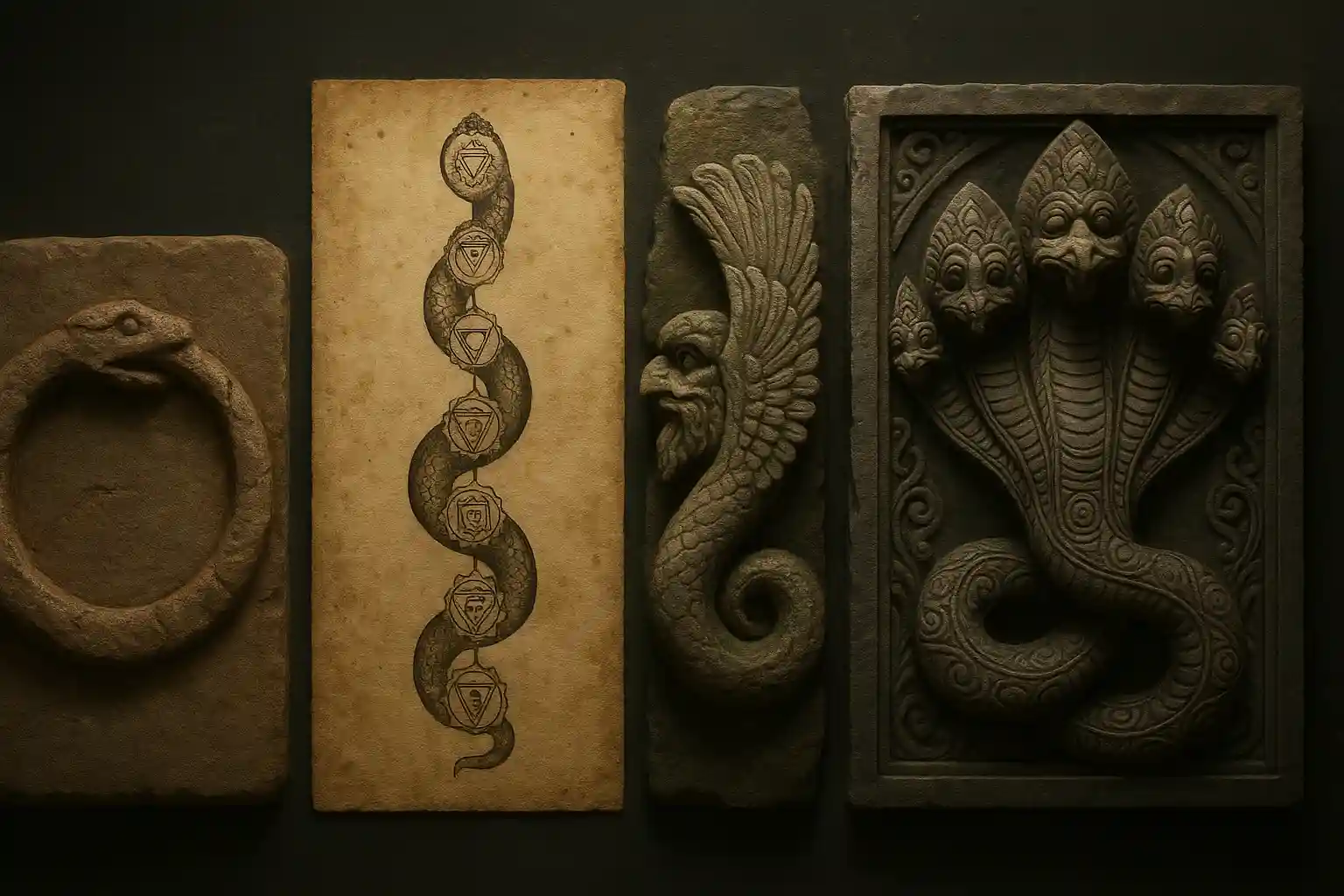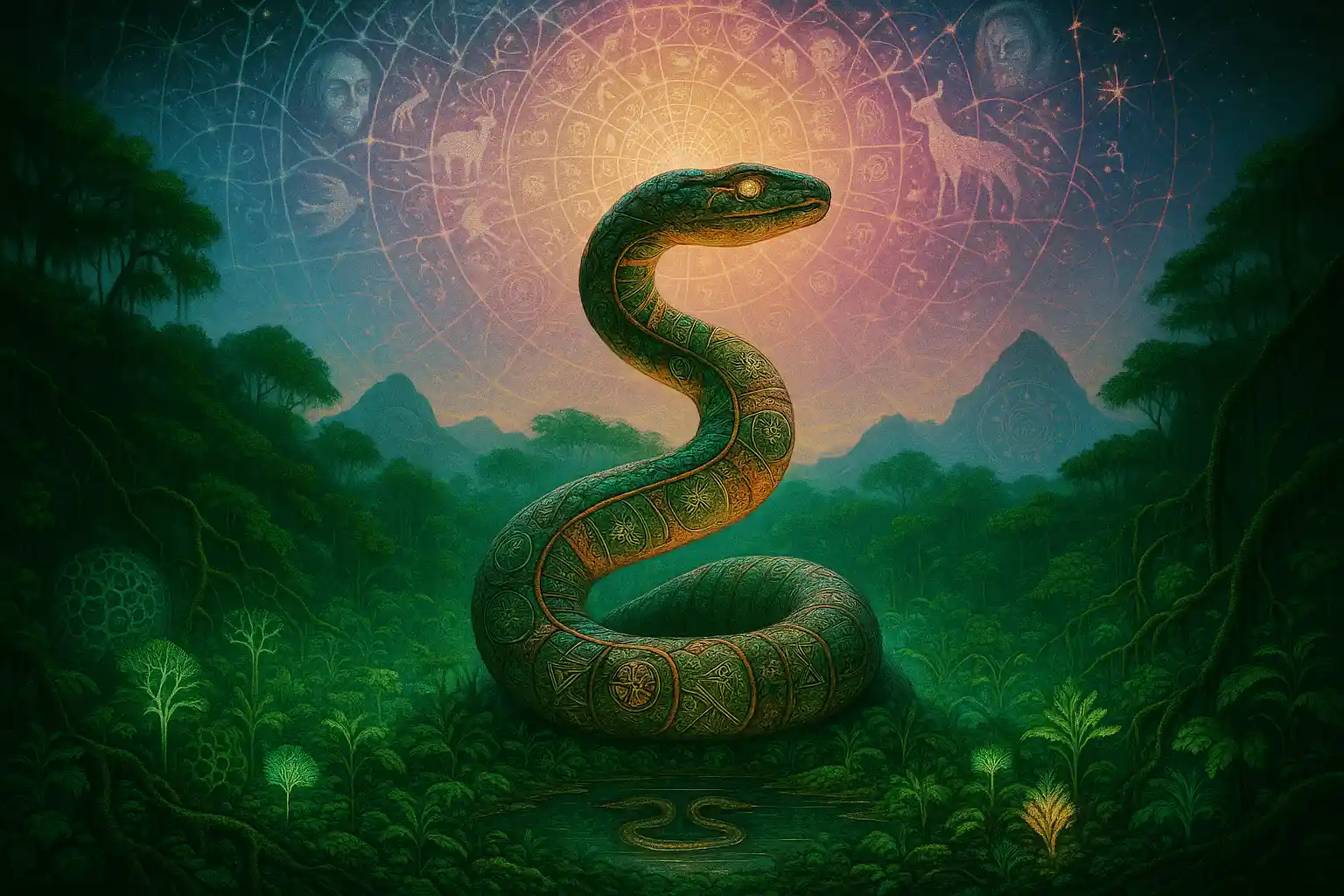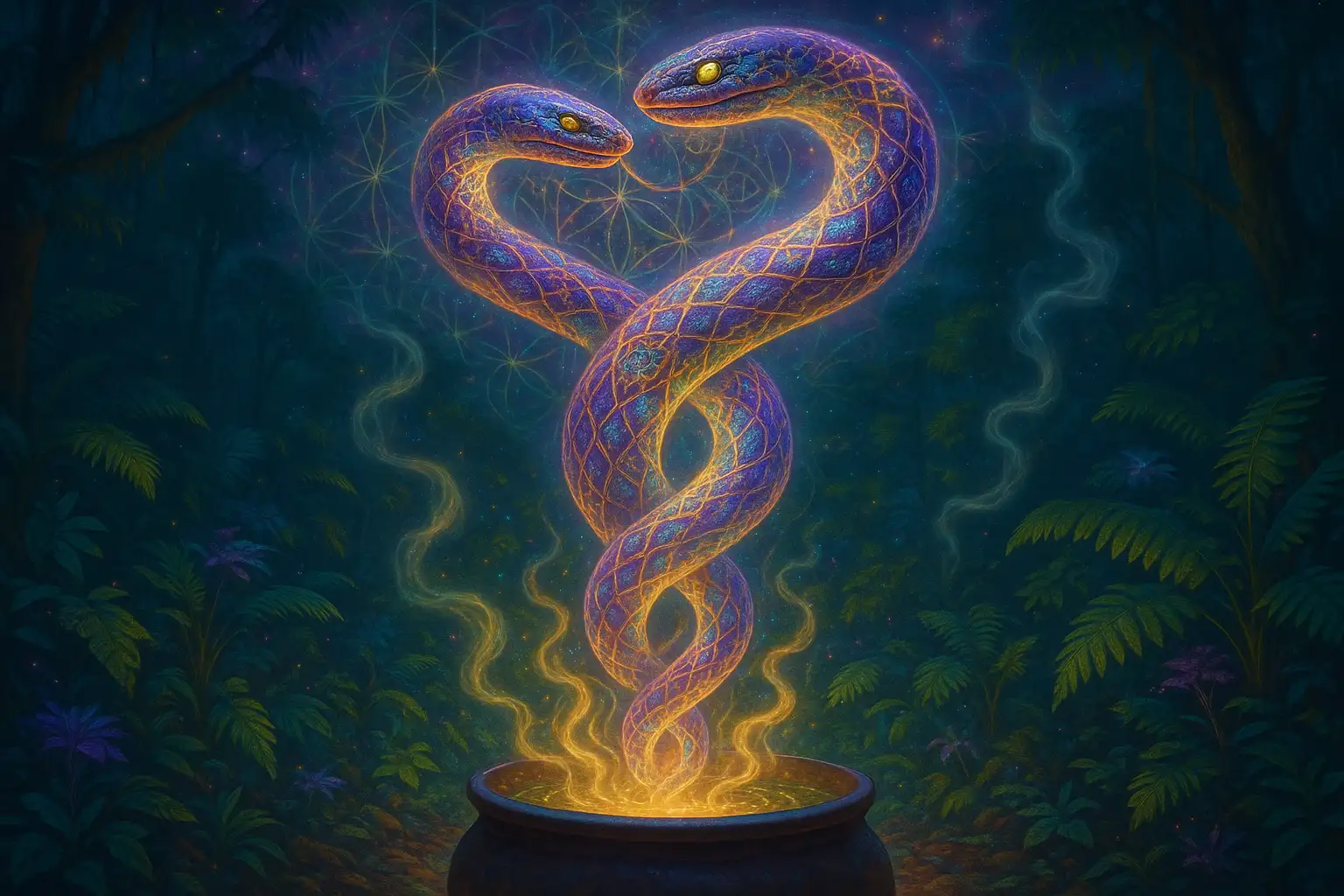What if the serpent visions in ayahuasca ceremonies are more than metaphor? From Peruvian rainforests to dimethyltryptamine (DMT) realms, the same coiling figure reappears – luminous, sentient, and strangely familiar.
When anthropologist Jeremy Narby suggested these ancient visions might connect to DNA itself, he triggered fierce debate. Could these serpents be symbolic transmissions from the very blueprint of life? The question winds through visionary experience, molecular biology, and the contested edges of knowledge itself.
Serpent Encounters in Shamanic Traditions
Across continents and cultures, the serpent slithers into the heart of myth and medicine alike. In the altered states induced by powerful entheogens (plant medicines that reveal the divine within) it reappears with uncanny consistency – intelligent, radiant, and intimately aware.
In the ceremonial darkness of Amazonian rituals, where the ayahuasca brew (a powerful visionary concoction of vine and leaf) opens portals to other states of being, the serpent often arrives unbidden.
Pablo Amaringo, the Peruvian shaman-artist whose visionary paintings became legendary, captured what many can only describe in whispers. His intricate works show serpents everywhere – radiating violet light, teaching healing songs, emerging from the very brew itself.
“Out of the ayahuasca vine comes a black snake with yellow, orange, and blue spots,” Amaringo documented. “From its mouth comes a violet radiation.”
These aren’t passive images floating through consciousness. Shamans report direct communion with these beings. The serpents teach specific healing techniques, reveal medicinal properties of plants, and impart cosmic knowledge through what appears to be non-verbal communication.
In Amaringo’s visions, spirits emerge from ayahuasca pots to teach him how to blow healing smoke and which plants cure particular ailments.
The experience transcends ayahuasca. DMT users frequently encounter what they describe as “4th-dimensional cosmic snakes” that seem to know them intimately.
One account describes: “It spoke without words, delivered messages that hit me at the core of my existence.” These entities don’t merely appear – they engage, communicate, and transmit knowledge through means that defy ordinary explanation.
Academic research confirms that 94% of DMT users report encounters with seemingly autonomous beings, many taking serpentine forms. Even psilocybin experiences (induced by the active compound in psychedelic mushrooms) include morphic, snake-shaped patterns, suggesting a deep-seated pattern in how altered consciousness manifests archetypal forms.
Across various entheogenic traditions, from mushroom ceremonies to iboga (an African root used in spiritual initiations) rituals, similar reports of serpentine entities emerge, each carrying their own cultural flavour whilst maintaining the core characteristics of intelligence and teaching.
The method of communication in these experiences bears noting. It is not verbal. It is immediate: through symbolism, emotion, direct knowing. The serpent becomes a conduit through which non-ordinary information is transferred, often with a didactic tone that suggests genuine teaching rather than mere hallucination.
The Cosmic Serpent Hypothesis
In his 1998 book The Cosmic Serpent, Jeremy Narby proposed that the serpents seen in visionary states are more than archetypal symbols. He argued they are intuitive visions of DNA itself.
Narby, trained as an anthropologist, spent years living with the Ashaninca people in the Peruvian Amazon, initially cataloguing their rainforest knowledge for conservation purposes. There, he observed that indigenous healers claimed to gain complex botanical knowledge through visions.
This prompted a radical question: how did these shamans possess such intricate understanding of plant pharmacology? The traditional explanation (millennia of trial and error) seemed insufficient given the complexity and precision of their knowledge.
Then came his own ayahuasca experience. Visions of twin snakes, luminous and intertwined, led him to a radical hypothesis:
- What if these visions represented something far more literal than metaphor?
- What if shamans were somehow accessing information at the molecular level, perceiving the double helix of DNA through visionary states?
His thesis suggested that shamans could gain direct, intuitive access to biological information encoded in plants’ genetic material through ayahuasca-induced states. For Narby, this wasn’t mere pattern recognition. He suggested that the profound botanical knowledge of Amazonian healers came through direct communication with what he termed “the intelligence of nature” a living network of information accessible through altered consciousness but invisible to ordinary scientific methods.
The hypothesis challenged multiple orthodoxies simultaneously. It questioned the assumed superiority of Western scientific epistemology whilst proposing that ancient shamans had accessed knowledge about life’s fundamental structures millennia before Watson and Crick identified the DNA double helix in 1953.
When Science Bites Back

The scientific community’s response was swift and largely damning. Biophysicist Jacques Dubochet criticised Narby for failing to propose testable hypotheses.
Publishers Weekly accused him of mistaking “enthusiasm for evidence.” Many reviewers dismissed his work as speculative metaphor masquerading as biological fact.
The criticisms cut deep. Narby’s suggestions about biophotonic emissions from DNA as a means of communication were attacked for lacking a “reasonable physical basis.” One geneticist delivered a particularly scathing assessment, characterising him as “an excellent anthropologist but a dirt-poor biologist.” The academic consensus was harsh – whilst his hypothesis might theoretically be falsifiable, it was fundamentally “rooted in metaphor” rather than empirical evidence.
Critics pointed out that the visual resemblance between twin serpents and the DNA double helix was purely analogical. The leap from seeing serpentine forms in visions to claiming direct molecular communication represented a profound category error, they argued.
Narby’s understanding of biomolecular concepts, particularly regarding DNA function and biophoton emissions, was questioned as outdated or simply incorrect.
Yet beyond the technical critiques lay a deeper tension. Narby’s work struck a chord beyond academic circles precisely because it highlighted uncomfortable questions about the nature of knowledge itself. If indigenous shamans possessed sophisticated understanding of medicinal plants through visionary means, what did this say about the limitations of empirical science?
The tension wasn’t merely about biological facts – it was about competing ways of knowing.
The Ubiquitous Serpent Motif

Regardless of the scientific fate of Narby’s specific DNA hypothesis, the serpent’s potent and recurring appearance in visionary states is undeniable.
This experiential phenomenon resonates deeply with the serpent’s ancient and ubiquitous presence in human mythology worldwide, long predating modern biological understanding.
From the Ouroboros of Egyptian and Norse texts to the coiled Kundalini of yogic tradition, from the Rainbow Serpent of Aboriginal Australia to Quetzalcoatl of the Aztecs, the snake often marks the threshold between worlds.
In Egypt, the Ouroboros (a serpent eating its own tail) symbolised the eternal cycle of life, death, and rebirth. Norse mythology featured Jörmungandr, the world-encircling serpent. The Hindu concept of Kundalini depicts a coiled serpent at the base of the spine, whose awakening leads to spiritual enlightenment. Mesoamerican cultures worshipped the Feathered Serpent – Quetzalcoatl to the Aztecs, Kukulkan to the Maya. This entity bridged earth and sky, embodying dual nature and serving as a gateway to the spirit realm.
The Maya Vision Serpent acted as a conduit between worlds, with ancestors and gods emerging from its mouth during bloodletting rituals. In Hindu and Buddhist traditions, Nagas represent powerful serpent beings, guardians of wisdom and sacred treasures. Even the pre-Inca Chavín culture featured complex bicephalic serpents in their iconography, often associated with cosmic order and transformation.
What unites these disparate visions is not just form, but function. The serpent opens doors. It guides or warns. It brings insight, at a cost. Transformation (through skin-shedding), knowledge (often forbidden), healing power, guardianship of sacred spaces; the duality remains constant across cultures – creator and destroyer, poison and medicine, wisdom and danger.
It is also, notably, a mediator. In Mayan ritual, the Vision Serpent delivers ancestors and deities through its mouth. In Hindu iconography, serpents guard the hidden forces at the base of the spine. In Genesis, the serpent is both deceiver and knowledge-bearer.
The Serpent in the Brain
Neuroscience and Pattern Recognition
While ancient myths offer rich symbolic tapestries, modern neuroscience seeks to unravel whether these recurring serpentine visions have correlates within the very architecture of the human brain.
Heinrich Klüver’s groundbreaking work identified “form constants” – fundamental geometric patterns the brain may generate under altered conditions. These recurring spirals, tunnels, and lattices in psychedelic visions might be interpreted as snake-like by our pattern-seeking minds. These patterns arise from the visual cortex’s fundamental architecture. When psychedelics disrupt normal processing, the mathematical relationship between retina and visual cortex can transform simple neural activity into complex geometric forms.
Also, humans have a well-documented evolutionary sensitivity to snakes.
Evolutionary neuroscientist Lynne Isbell proposes that an ancient arms race between mammals and serpents led to neural modules specifically evolved to detect snake-like shapes. The visual acuity required to spot camouflaged serpents may have driven the development of primate brain capacity. Our brains are literally hardwired to notice snakes.
Psychedelics, primarily acting on serotonin 5-HT2A receptors (key brain receptors that are primary targets for psychedelic compounds), create profound changes in cortical dynamics.
The “Relaxed Beliefs Under Psychedelics” (REBUS) model suggests these substances reduce the precision of high-level priors – our expectation filters that normally constrain perception. This allows unusual sensory information and intrinsic brain activity to reach conscious awareness.
“Still, this does not explain why the serpents speak.”
A crucial explanatory gap remains. Neuroscience can describe how the brain generates visual forms and altered states, but struggles to account for the rich semantic content, perceived intelligence, and specific informational exchange reported in serpent encounters.
If not a direct vision of DNA, then what is the nature of the information these ancient traditions claim to receive?
DNA, Archetypes, and Memory Fields

Where neuroscience leaves off, other frameworks begin.
Carl Jung spoke of archetypes – universal symbols embedded in the collective unconscious. The serpent, in his view, embodied transformation, healing, the union of opposites. Jung himself encountered serpentine imagery in his explorations documented in “The Red Book.” Archetypal patterns shared across humanity might emerge when consciousness is altered.
Rupert Sheldrake’s controversial theory of morphic resonance proposes that nature itself carries an inherent memory, with information transmitted through non-local fields rather than genetic inheritance alone.
If morphic fields contain information about form and behaviour from the past, the appearance of archetypal serpents in visions might represent attunement to these collective patterns. The serpent, as a symbol of recurring life cycles and transformation, could manifest a particularly potent morphic field related to biological organisation.
“What if consciousness isn’t produced by the brain, but accessed through it? What if the serpent visions represent not hallucinations, but glimpses of information fields that predate individual minds: ancient patterns written into the very fabric of life itself?”
Indigenous cosmologies go further. To many Amazonian shamans, plants have spirits. These spirits teach. Many traditions speak of plants as teachers capable of direct knowledge transmission. The idea of biological or ecological memory (where information is encoded within nature itself) suggests visionary experiences might access genuine sources of wisdom invisible to conventional science.
Could these globally echoed myths point towards a fundamental, shared human experience of this powerful archetype? Whether one sees these explanations as poetic or literal, they converge on a single point – the serpent is a transmitter.
The Question That Won’t Die
The visionary serpent refuses domestication. It appears in temples, dreams, and under the skin of altered perception. It suggests that information, once hidden, may have other routes into the mind.
Jeremy Narby’s theory may not hold up to experimental scrutiny. Yet the core mystery remains – why do seekers across time and culture encounter the same writhing, watching form at the threshold of insight?
The cosmic serpent continues to coil through human experience, carrying questions that demand we expand not just our science, but our very notion of what it means to know.
Whether we interpret these visions as symbolic manifestations of archetypal patterns, intuitive glimpses of biological structures, or something beyond current comprehension, the phenomenon points to possibilities that conventional science struggles to address.
Perhaps the serpent is not just something seen. Perhaps it is something that sees. Something ancient, intelligent, and embedded in the very structure of life.
The question, as ever, is not whether it is real. The question is… why does it return?
Sources consulted include ethnographic accounts from Amazonian shamans, Jeremy Narby’s “The Cosmic Serpent,” contemporary neuroscience research on psychedelics, cross-cultural mythological studies, and recent investigations into consciousness and perception.

Comments (0)